Saturday August 24, 2019
Canberra’s inland location means that winter lingers a little longer here and overnight temperatures had fallen to -5C (23F) resulting in a frosty morning. After a superb breakfast at the hotel I decided to linger in the warm a little longer to fix a couple of issues I experienced yesterday with the program I use to capture the road videos. The program runs on a tablet and, in Australia, it is illegal to have any display visible to the driver that is not a driving aid. Before the trip I had programmed and tested voice commands to allow me to control the program with the screen turned off but it was misinterpreting music lyrics and GPS instructions as commands. Based on limited driving around Canberra today, a couple of hours of coding seems to have fixed the problem but I guess I’ll have to see on a longer drive.
I decided that Canberra could provide my introduction to all things Australian and, with the temperature climbing and clear blue skies overhead, I set off for my first destination, the National Museum of Australia. This impressive structure houses three major permanent exhibits. “Encountering Australia” explores how people react to and interact with the unique plants, animals and environment, “Living with the Land” traces how different ways of life have developed across the country and “Understanding Australia” considers how people’s knowledge of the land and its history have shifted over time. Another significant exhibit is an introduction to Aboriginal cultures and how the arrival of settlers changed them.
I then took a short break at the Mount Ainslie Lookout which provides a sweeping view of the capital city before heading back to the Australian War Memorial. From a distance this looks like it is just a memorial but it is actually a beautifully designed memorial and large museum. Australian forces lost nearly 100,000 lives in the First and Second World Wars and the two main exhibits focus on these. For me, the displays describing the conflicts that took place in this part of the world were particularly educational.
Every day the memorial closes with a Last Post Ceremony which, today, honored a young soldier who lost his life at age 24 in WWI. The memorial also houses a bronze Roll of Honour which lists the names of over 102,000 Australians who died in war related situations with a poppy for each one. The whole approach of the memorial is one of education and respect for the sacrifices of war. There was no bravado and even an acknowledgement of the futility of war came through at times.
The impressive atrium at the National Museum of Australia.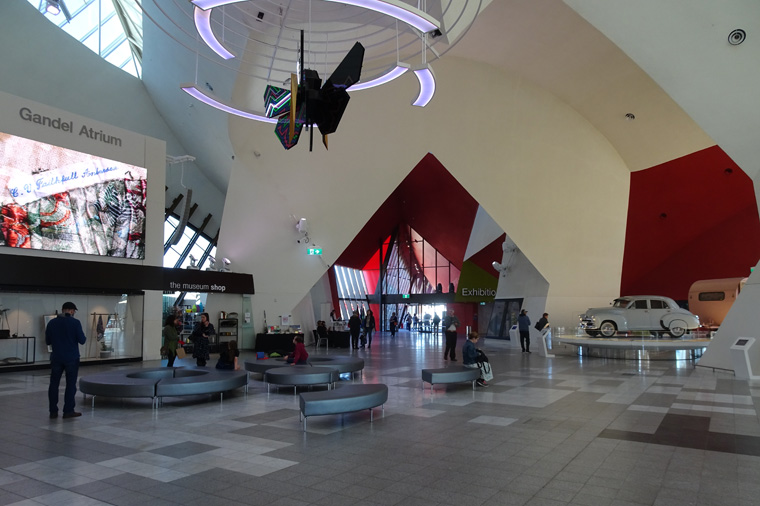
The museum building is circular and surrounds a large water feature representing a map of much of Australia. 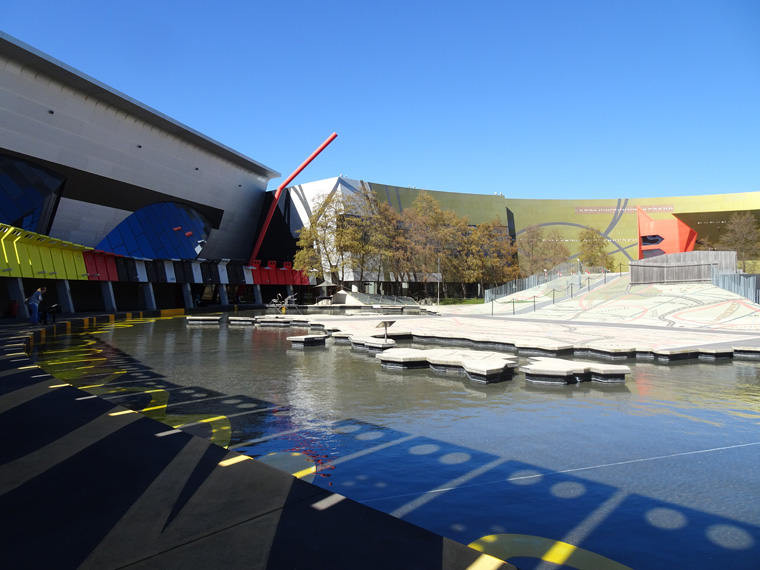
The view from Mount Ainslie Lookout. Click for a larger version.
The main axis of the city showing the War Memorial in the foreground and Parliament House at the far end.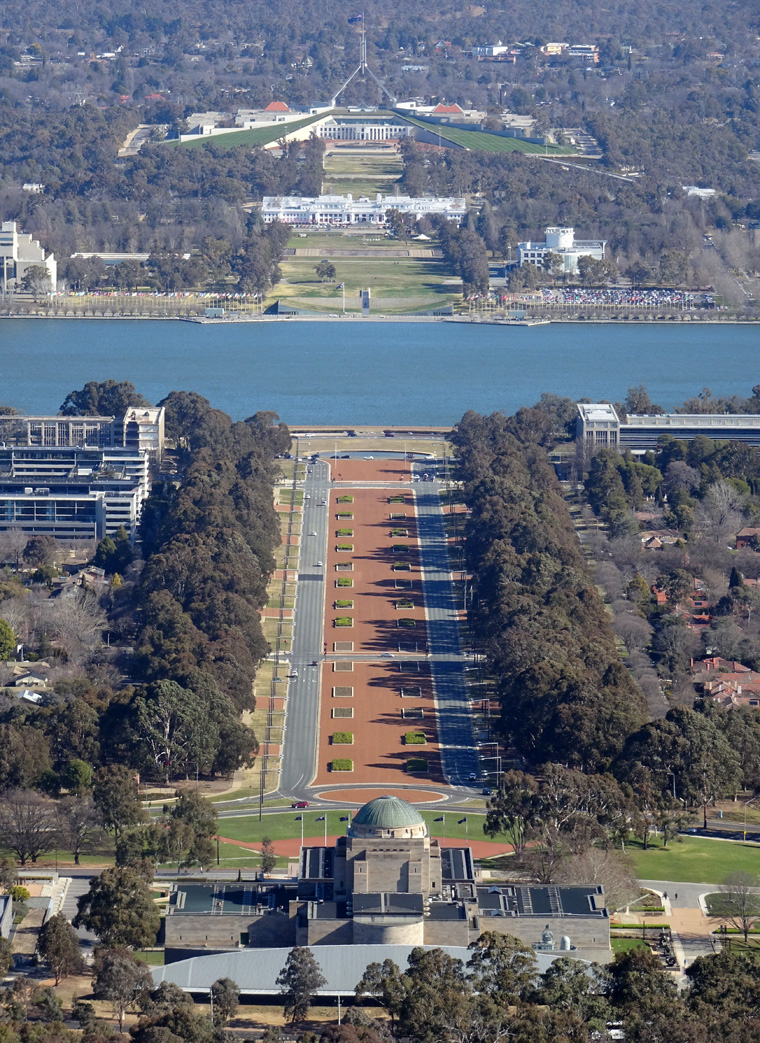
The Australian War Memorial featured dozens of detailed explanatory dioramas like this.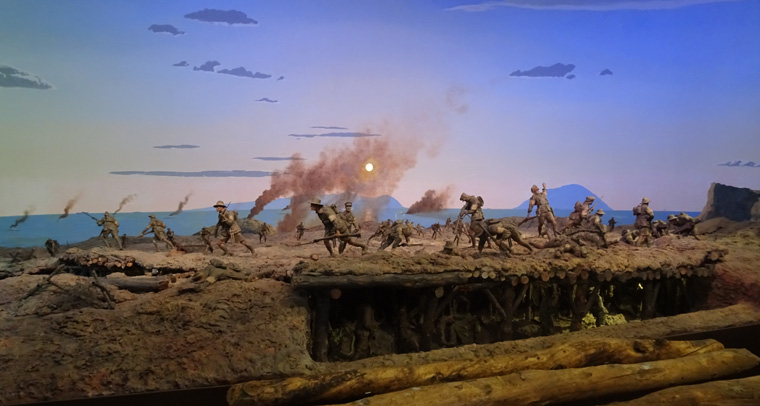
The memorial section, showing the reflecting pool and eternal flame. This was shortly after the Last Post Ceremony.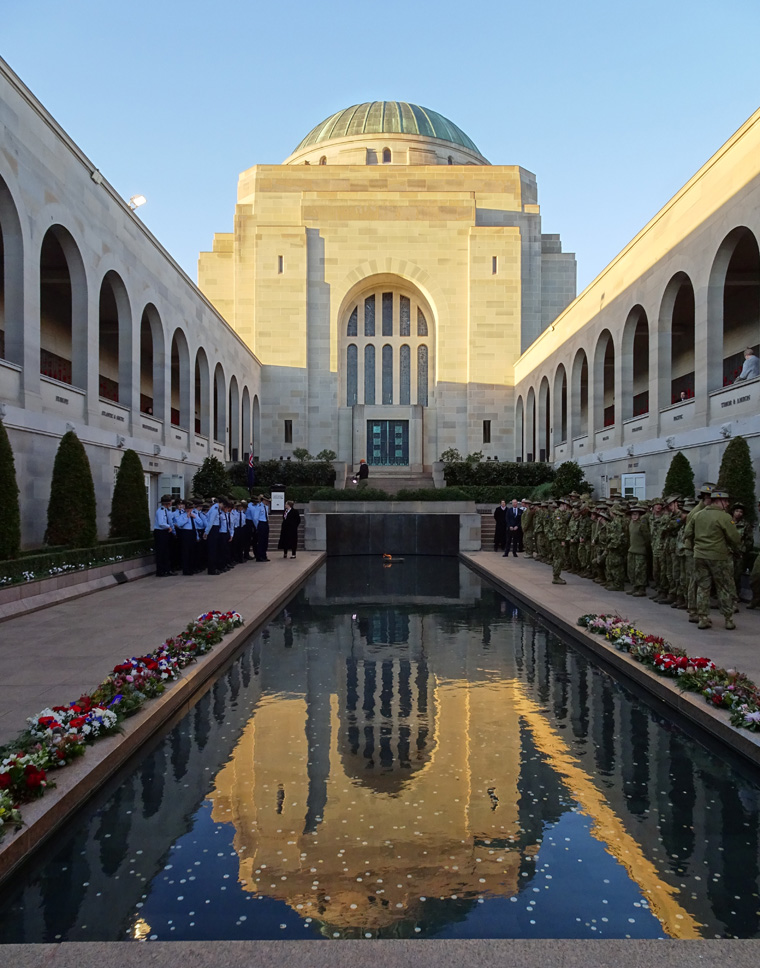
A small portion of The Roll of Honour.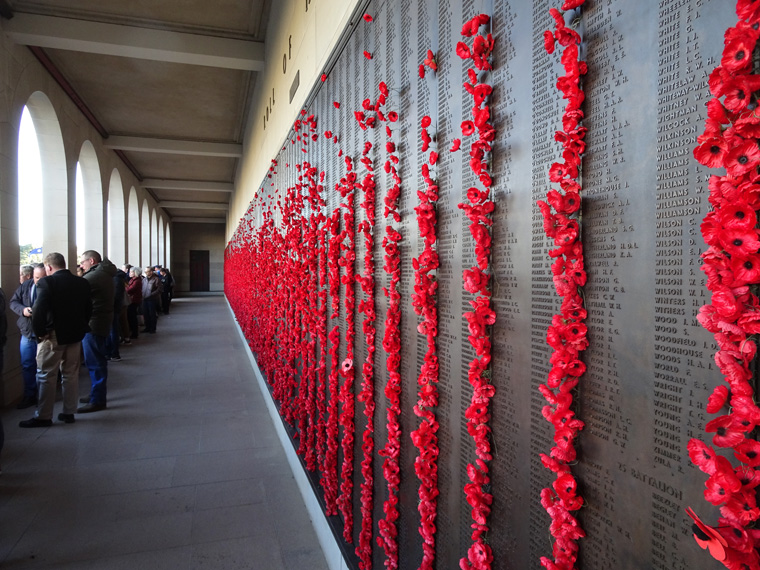
Sunday August 25, 2019
Road video and map – Canberra to Gundagai
After a relaxing Sunday breakfast I headed back to central Canberra to visit the National Gallery of Australia and to tour Parliament House.
The National Gallery is famous for its large collection of Aboriginal and Torres Strait Islanders pieces and this was the main reason that I decided to visit. As with many indigenous cultures, many of the paintings represented stories of ancestors and family or the connection between the people and the land and employed bright colors but these appeared more detailed and used a wider variety of materials than North American Native art. Some of the more modern pieces were darker in tone and delivered political messages.
After enjoying significant time in the indigenous galleries I came across an exhibit of Indonesian art since 1998 that I found to be very stimulating. Maybe that’s because I do not visit enough modern art galleries or maybe it’s due to the intellectual awareness and freedom of expression liberated by the change to democracy in Indonesia, I don’t know, but the variety and creativity in the exhibit astounded me. Unfortunately, I did not get to spend as much time as I would have liked exploring the galleries as I had booked a 1PM tour of Parliament House.
Although it is always interesting to see different approaches to the settings and procedures of lawmaking the basic approach in western style democracies is usually very similar. Not surprisingly, most elements of the Australian parliament follow the British model but, unlike Westminster, the lawmakers do their work in a modern complex with 4,700 rooms that opened in 1988. After explaining how Canberra was chosen to be the capital our guide took us through several main rooms, including the House of Representatives and the Senate.
I then made the 100 mile drive from Canberra to Gundagai, NSW which will reduce the driving time tomorrow.
Traditional Aboriginal painting at the National Gallery of Australia.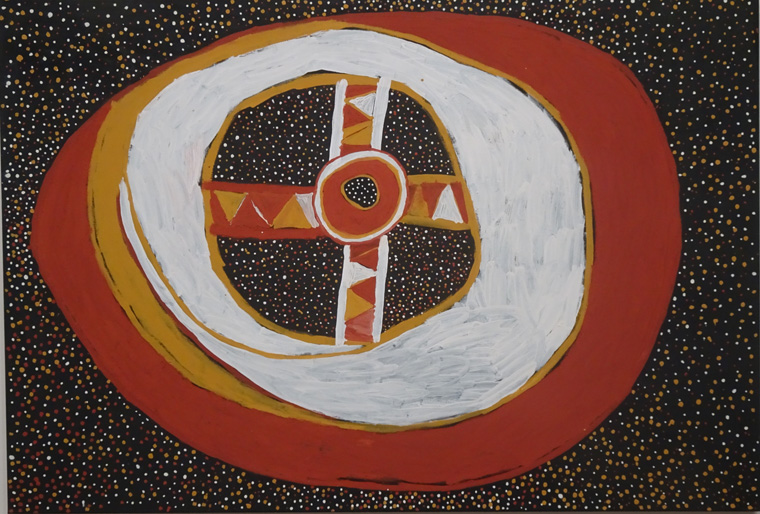 and a bark painting.
and a bark painting.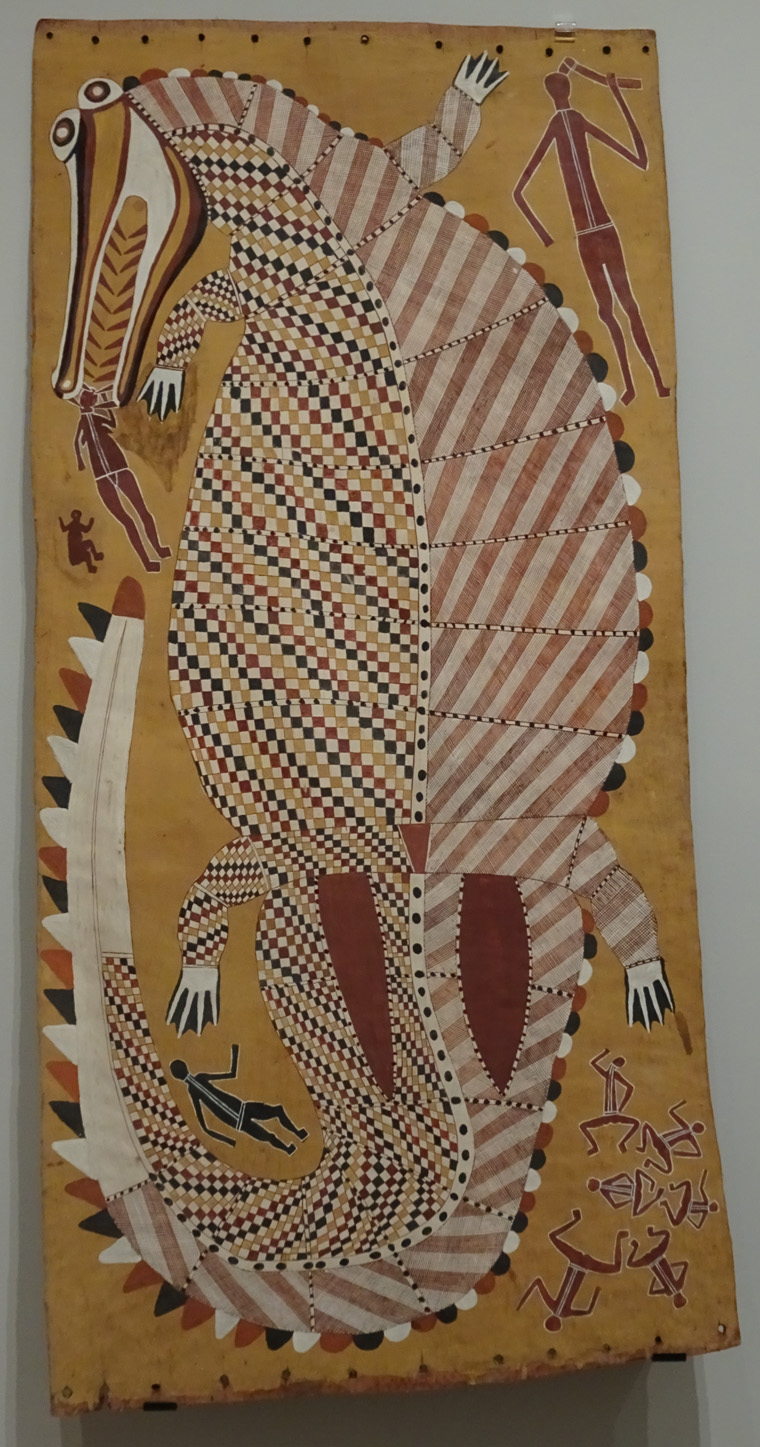
A short video showing part of the sequence of a large neon installation from Indonesia depicting the interdependence, motivations and dark side of the three pillars of the art world, the artist, the dealer and the collector.
The Senate Chamber at Parliament House.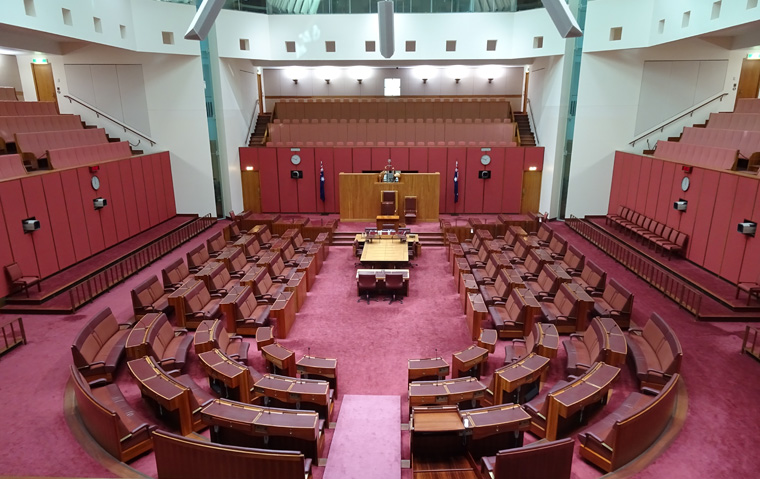
The front of the huge Parliament House complex.

Your photos and explanations are the best yet – or perhaps my interest in Australia is greater. Nevertheless, it does seem that this record of your Australian trip could well be an enticement to the Australian embassy on your return. The photography is splendid! On the comment side, however, I do miss a little further detail; after being drawn in by such comments as “Another significant exhibit is an introduction to Aboriginal cultures and how the arrival of settlers changed them” ( anything in particular??) and “For me, the displays describing the conflicts that took place in this part of the world were particularly educational.” (what did you learn?) The wish for more detail is merely due to your engaging story-line!!
Glad all is going well! Cheers, Leith
Hi Leith, Thanks for the compliments. I am really enjoying the trip so far and glad to have you along for the drive.
Thanks also for the observations about missing detail. When writing the blog posts I always try to offer a bit of color as to how I am reacting to things but I don’t want to make the posts long. This is proving very difficult on this trip because everything is new and I find there are many things each day that I would love to write about but am omitting. I am always happy to reply to a comment, like yours, asking a specific question.
As far as I can tell the effect of settlers on the native cultures was similar to North America (displacement, dishonored agreements, family and communities divided and little opportunity to access political or economic power) but was not as violent. It appears as if native peoples accepted the intruders and wanted to work with them but the settlers mistook the unstructured communities as nomadic since they did not use the concept of property ownership. There does seem to be a greater acceptance of the mistreatment of native peoples here and significant attempts to encourage the many cultures to redevelop and flouris.
At the War Memorial the displays included much more information about the conflicts that occurred in the western Pacific and around the islands north of Australia. I had not realized the extent to which Japan had threatened Australia in WWII or that they had actually launched attacks on Darwin and Sydney.
Cheers, Steve.
Superb photographs. Thank you for sharing, love, Kusum
Thank you for the compliment and following along.
Two thumbs up